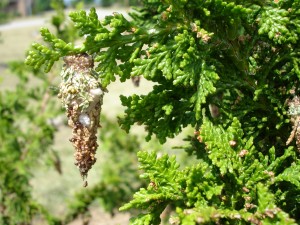Bagworms feed on more than 128 species of plants, including junipers, cedars, arborvitae and white pine. More than one year of severe defoliation will kill a formerly healthy specimen. Bagworms have one generation per year. Eggs usually hatch in mid to late May across the Southern Appalachian region (USDA zones 6 and 7).
Upon hatching, the young larvae crawl out of the bottom of the bag and begin eating plant foliage. Maturing larvae can do considerable defoliation during early summer. As the worms age, they construct a silken shelter over their body and are more difficult they are to kill.
Bagworms’ carrot-shaped bag is constructed of bits of material from the plant upon which it’s feeding and expands as the bagworm grows. The bag is carried wherever the worm goes. When disturbed, the bagworm merely pulls its head back into its bag for protection.
Insecticides should be applied when the bagworms are small, but after all have hatched by early June. After mid-June pesticide control is too late. Complete spray coverage is essential. Carbaryl (Sevin), Bt (Dipel), Malathion, acephate (Orthene), and pyrethroids like bifenthrin (Talstar), cyfluthrin, and permethrin), and spinosad (Conserve SC) are highly recommended. Spinosad controls the hard to kill older bagworms.


 Posted in
Posted in 
